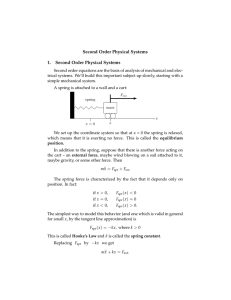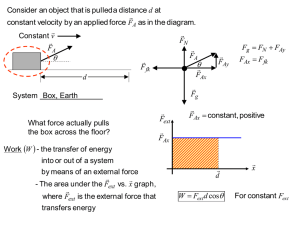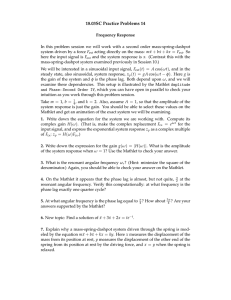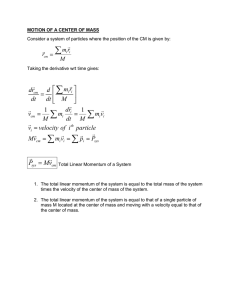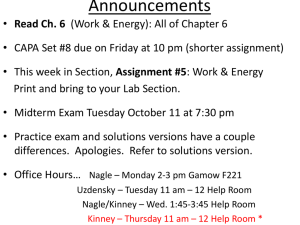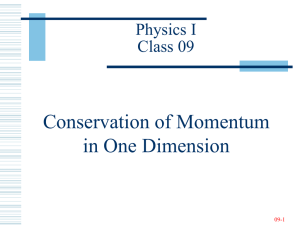The ITU-T`s New G.vector Standard Proliferates 100 Mb/s DSL
advertisement
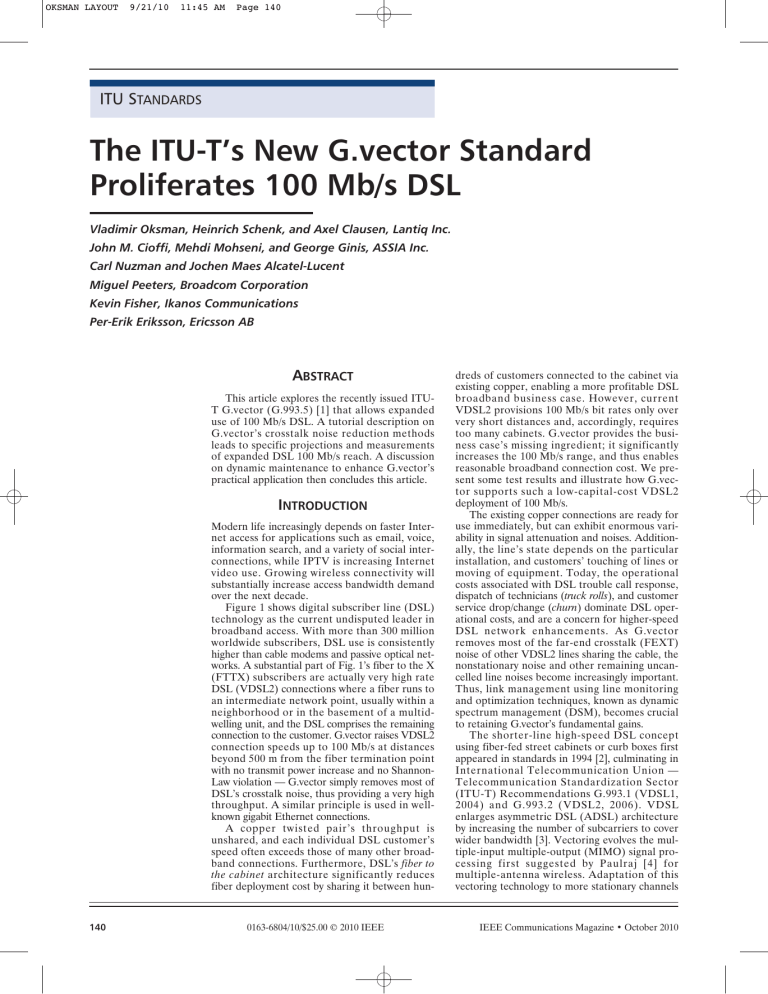
OKSMAN LAYOUT 9/21/10 11:45 AM Page 140 ITU STANDARDS The ITU-T’s New G.vector Standard Proliferates 100 Mb/s DSL Vladimir Oksman, Heinrich Schenk, and Axel Clausen, Lantiq Inc. John M. Cioffi, Mehdi Mohseni, and George Ginis, ASSIA Inc. Carl Nuzman and Jochen Maes Alcatel-Lucent Miguel Peeters, Broadcom Corporation Kevin Fisher, Ikanos Communications Per-Erik Eriksson, Ericsson AB ABSTRACT This article explores the recently issued ITUT G.vector (G.993.5) [1] that allows expanded use of 100 Mb/s DSL. A tutorial description on G.vector’s crosstalk noise reduction methods leads to specific projections and measurements of expanded DSL 100 Mb/s reach. A discussion on dynamic maintenance to enhance G.vector’s practical application then concludes this article. INTRODUCTION Modern life increasingly depends on faster Internet access for applications such as email, voice, information search, and a variety of social interconnections, while IPTV is increasing Internet video use. Growing wireless connectivity will substantially increase access bandwidth demand over the next decade. Figure 1 shows digital subscriber line (DSL) technology as the current undisputed leader in broadband access. With more than 300 million worldwide subscribers, DSL use is consistently higher than cable modems and passive optical networks. A substantial part of Fig. 1’s fiber to the X (FTTX) subscribers are actually very high rate DSL (VDSL2) connections where a fiber runs to an intermediate network point, usually within a neighborhood or in the basement of a multidwelling unit, and the DSL comprises the remaining connection to the customer. G.vector raises VDSL2 connection speeds up to 100 Mb/s at distances beyond 500 m from the fiber termination point with no transmit power increase and no ShannonLaw violation — G.vector simply removes most of DSL’s crosstalk noise, thus providing a very high throughput. A similar principle is used in wellknown gigabit Ethernet connections. A copper twisted pair’s throughput is unshared, and each individual DSL customer’s speed often exceeds those of many other broadband connections. Furthermore, DSL’s fiber to the cabinet architecture significantly reduces fiber deployment cost by sharing it between hun- 140 0163-6804/10/$25.00 © 2010 IEEE dreds of customers connected to the cabinet via existing copper, enabling a more profitable DSL broadband business case. However, current VDSL2 provisions 100 Mb/s bit rates only over very short distances and, accordingly, requires too many cabinets. G.vector provides the business case’s missing ingredient; it significantly increases the 100 Mb/s range, and thus enables reasonable broadband connection cost. We present some test results and illustrate how G.vector supports such a low-capital-cost VDSL2 deployment of 100 Mb/s. The existing copper connections are ready for use immediately, but can exhibit enormous variability in signal attenuation and noises. Additionally, the line’s state depends on the particular installation, and customers’ touching of lines or moving of equipment. Today, the operational costs associated with DSL trouble call response, dispatch of technicians (truck rolls), and customer service drop/change (churn) dominate DSL operational costs, and are a concern for higher-speed DSL network enhancements. As G.vector removes most of the far-end crosstalk (FEXT) noise of other VDSL2 lines sharing the cable, the nonstationary noise and other remaining uncancelled line noises become increasingly important. Thus, link management using line monitoring and optimization techniques, known as dynamic spectrum management (DSM), becomes crucial to retaining G.vector’s fundamental gains. The shorter-line high-speed DSL concept using fiber-fed street cabinets or curb boxes first appeared in standards in 1994 [2], culminating in International Telecommunication Union — Telecommunication Standardization Sector (ITU-T) Recommendations G.993.1 (VDSL1, 2004) and G.993.2 (VDSL2, 2006). VDSL enlarges asymmetric DSL (ADSL) architecture by increasing the number of subcarriers to cover wider bandwidth [3]. Vectoring evolves the multiple-input multiple-output (MIMO) signal processing first suggested by Paulraj [4] for multiple-antenna wireless. Adaptation of this vectoring technology to more stationary channels IEEE Communications Magazine • October 2010 Page 141 G.993.5 STANDARD VECTORED TECHNOLOGY FEXT CANCELATION PRINCIPLES The dominant VDSL2 noises are near-end crosstalk (NEXT, between transmitters and receivers connected to different pairs of a multipair cable at the same end), far-end crosstalk (FEXT, between transmitters and receivers connected to different pairs of a multipair cable at opposite ends; Fig. 2), and background Gaussian noise [3]. NEXT coupling is usually so strong above 1–2 MHz that VDSL2 systems use nonoverlapping downstream/upstream frequency bands multiplexing up to 30 MHz. Thus, with NEXT largely eliminated, FEXT may dominate the remaining noise. G.vector technology cancels VDSL2’s mutual FEXT, thus effecting a performance improvement. In a typical VDSL deployment, multiple VDSL2 lines connect the DSLAM to the VDSL transceiver unit — remote terminals (VTU-Rs) at physically separated individual residences’ CPs. VDSL2 uses digital multitone (DMT) modulation [9] with up to 4096 subcarriers located on frequencies fi, spaced by Δf = 4.3125 kHz or Δf = 8.625 kHz (f i = i × Δf, i = 0, 1, …, 4095). Each subcarrier carries a certain number of bits that depends on this subcarrier’s signal-to-noise ratio (SNR). FEXT cancellation reduces noise and thus can increase these SNRs. This allows carriage of more bits and therefore increases the line’s data rate. FEXT generated by a particular twisted pair m into a victim twisted pair l can be cancelled at the subcarrier frequency f i by subtracting from the received signal the value of the signal Um(fi), transmitted over the pair m, multiplied by the FEXT transfer function from the pair m into the pair l, H l–m (f i ). If the cable binder includes N pairs, and FEXT has to be cancelled on M subcarriers, the subtracted crosstalk signal comprises (N – 1) × M components, where each component corresponds to a particular binder pair’s FEXT into the victim line on the particular subcarrier frequency. Each subcarrier’s (f i) crosstalk signal is obtained by multiplication of the signal vector u and the FEXT coupling vector H, both of size N; hence the name vectoring. IEEE Communications Magazine • October 2010 350 DSL Cable modem FTTx 300 250 200 150 100 50 9 Q 20 8 Q 10 9 Q 40 8 8 7 Q 30 8 Q 20 Q 10 7 7 7 Q 40 Q 30 Q 20 Q 10 6 0 6 first appears in [5] and was continually refined for DSL in 1999 and 2000 [6]. A reduced complexity near-optimal implementation of linear vectoring was proposed in [7]. Complexity of vectoring is still challenging, especially for large numbers of vectored subscribers. Vectored DSL proposals first appeared in the American National Standard Institute (ANSI) in the 2001 DSM project [8] as the highest of three levels of crosstalk noise control methods for copper loop management. Vectored DSLs have physically separated customer premises (CP) locations that cannot be coordinated directly by a common customer-side controller. Recommendation G.993.5 describes the necessary interoperable line coordination functions at the DSL access multiplexer (DSLAM) and the individual lines’ training protocols within the coordinated vector group. Q 40 11:45 AM Q 30 9/21/10 Subscribers (in millions) OKSMAN LAYOUT Figure 1. Broadband access-connection for 2006–2009 (source: Point Topic). The DSLAM side must perform vectoring for both downstream and upstream, because DSLAM alone contains all the cable’s DSL signals (Fig. 2a). A downstream FEXT precoder precedes the modulation, and an upstream canceller follows the demodulation. The vectoring control entity (VCE) supplies updated channel matrices and controls the FEXT cancellation process, such as indicating from which lines to cancel FEXT. Such control allows efficient use of the available processing power to cancel dominant crosstalk. G.vector defines interoperability only for downstream vectoring, since upstream vector processing needs no interoperability specification. However, G.vector also specifies certain VTU-R control signals and timing that facilitate upstream vectoring: Figure 2a illustrates a potential vectoring implementation. Figure 2b defines each downstream line’s precoding for FEXT cancellation. The precoder, for each subcarrier frequency fi, multiplies the precanceller matrix Cp(fi) corresponding row by the signal vector u (f i ) of N lines. The VTU-R’s received vector, y(fi), will be: y = H ⋅ Cp ⋅ u + r, where H is the channel transfer matrix, r is the received non-FEXT noise vector, and the precanceller matrix, Cp, is equal to the inverted normalized channel matrix, H 0 = [diag(H)] –1 ⋅ H, and C p = H 0 –1 . Similarly, for upstream FEXT cancellation, the received signal vector can be described as y = Cc ⋅ H ⋅ u + r, and differs from the downstream case since the H is different. Vectoring also involves timing requirements. The DSLAM strictly aligns all lines’ upstream and downstream DMT symbols to typically within 1 μs. The DSLAM adjusts each vector group VTUR’s upstream timing advance value to meet this small tolerance. Also, all vectored lines transmit downstream sync symbols at the same time, while VTU-Rs transmit all upstream sync symbols also at the same time. This alignment eliminates syncsymbols’ FEXT into data symbols, as in Fig. 3. To align all upstream vectored lines’ sync symbols, the DSLAM sends the VTU-R a special time marker during the line’s initialization, which indicates the time offset between the upstream and downstream sync symbols, and thus allows the new line’s VTU-R to align its transmitted syncsymbol position with that of other lines. 141 OKSMAN LAYOUT 9/21/10 11:45 AM Page 142 DSLAM Upstream FEXT Symbol encoding TX line 2 Symbol encoding TX line N Symbol encoding IDFT modulation IDFT modulation IDFT modulation Downstream FEXT AFE CP VTU-R AFE Cable AFE CP VTU-R VCE - Overall control - Update channel matrices Pre-canceller matrix Cρ for line k, (size (N-1)xM, from the VCE) Symbol decoding RX line 2 Symbol decoding RX line N Symbol decoding Upstream FEXT canceller Upstream RX line 1 CP VTU-R Downstream DFT de-modulation Symbol encoding DFT de-modulation TX line k DFT de-modulation Encoded symbols of all other N-1 vectored lines except line k FEXT pre-coder of line k TX line 1 Downstream FEXT pre-coder Downstream IDFT modulation AFE (a) (b) Figure 2. Functional description of upstream and downstream vectoring. FEXT ESTIMATION FEXT cancellation requires the FEXT coupling coefficients between all pairs of the vectored group at each subcarrier. FEXT coupling estimation between two pairs uses repeating pilot signals to determine the other pair’s FEXT component. Since FEXT that is not yet cancelled during joining may cause unacceptably high noise, the pilot signal is transmitted only during sync-symbols. All vectored lines’ syncsymbols thus are aligned in time and carry no user data; therefore, even full-power pilot signals sent during sync-symbols do not disturb vectored lines’ data transmission (Fig. 3). VDSL2 transmits a sync symbol every 256 data symbols. For FEXT estimation, a special binary pilot sequence modulates each line’s sync symbol on pre-assigned probe-tone subcarriers with indices equal to 10n, 10n + 2, 10n + 3, 10n + 4, 10n + 5, 10n + 6, 10n + 8, and 10n + 9 (n = 0, 1, 2, …). Flag-tone subcarriers with indices equal to 10n + 1 or 10n + 7 allow communication of standard VDSL2 online reconfiguration (OLR) signals. The reduced number of OLRcarrying subcarriers does not impact OLR robustness because the number of flag tones is still large enough (vectored lines are relatively short and use wide spectrum). The value of FEXT on flag tones is interpolated from adjacent probe tones. The DSLAM assigns different vector-group lines’ binary pilot sequences, which are usually selected as mutually orthogonal. The orthogonality speeds up and simplifies FEXT estimation that correlates victim lines’ measured receiver error values with the disturbing lines’ orthogonal sequences. One popular class of orthogonal 142 sequences are Walsh-Hadamard sequences, for which the length can be any power of 2. Apart from crosstalk estimation’s use of orthogonal pilot sequences, direct FEXT estimation methods like a least mean square (LMS) algorithm can be used successfully . Selection of a particular pilot sequences is vendor discretionary; each DSLAM vendor can fit the sequence to their preferred FEXT estimation algorithm. G.vector also describes an alternative FEXT estimation method that uses each vector group’s reported SNR values, as measured at the VTU-R [1]. REPORTING OF ERROR SAMPLES The VCE needs feedback from the VTU-R on errors that are signal distortions caused by uncompensated downstream FEXT in the pilot sequences of received downstream sync-symbols on subcarriers assigned for downstream FEXT precoding. Samples of errors help the adaptive determination of the FEXT coupling coefficients used in the precanceller matrix. Thus, each VTUR’s measured receiver error samples are reported via the backchannel to the VCE for FEXT estimation and precanceller matrix (Cp) computation. G.vector assures CP-to-DSLAM interoperability by standardization of backchannel parameters and formats of the reported error samples. Backchannel capacity and reported error sample accuracy are critical for the FEXT cancellation algorithm’s convergence speed. Error Samples — A given subcarrier’s error sample is the difference E = Z – D between the received complex signal Z and its intended constellation point D, normalized to the scale of a unit-magnitude constellation point. The VCE IEEE Communications Magazine • October 2010 OKSMAN LAYOUT 9/21/10 11:45 AM Page 143 Pilot signal bit m Line 1 Line 2 Line k (joining) Line N Pilot signal bit m+1 Pilot signal bit m+2 Data Sync Data Data Data Data Sync Data Data Data Data Sync Data Data Data Sync Data Data Data Data Sync Data Data Data Data Sync Data Data Sync Sync Data Data Sync Data Data Data Data Sync Data Data Sync Data Sync Data Data VDSL2 super frame VDSL2 super frame Time VDSL2 super frame Figure 3. Symbol alignment, sync-symbol alignment, and pilot bits in a vectored group. (Same in upstream and downstream; line k is at the beginning of the joining procedure). divides the downstream frequency spectrum into up to eight non-overlapping bands for flexible reporting. A particular band’s sync-symbol error samples are reported in a block floating point format that supports different backchannel capacities, FEXT estimation algorithms, and deployment scenarios. Grouping error samples into blocks saves backchannel bandwidth, since a common 4-bit exponent applies to both real and imaginary parts of all the block’s samples; this is effective because neighboring subcarriers’ error samples typically have similar magnitudes. A block may contain one error sample, 32 error samples, or all error samples of the band. Further bandwidth may be saved by frequency and time subsampling of the reported error samples (e.g., reporting only even subcarriers’ error samples or from only every third sync-symbol). Clipping of error sample components to a specified maximum magnitude to avoid a particular block’s exponent is unduly influenced by powerful impairments on certain subcarriers, such as radio frequency ingress (RFI), causing a loss of precision for the remaining subcarriers. The VCE configures the size of the mantissa between 0 (sign only) and 8 bits. The VCE configures the bands and format of error sample reporting, and can adjust the error feedback accuracy by selecting an appropriate mantissa length and matching the backchannel bandwidth through grouping and subsampling. The VTU-R may also flag a particular report as potentially corrupted (e.g., by impulse noise) and report the error’s mean value over the vectored band, thereby assisting the DSLAM assessment of FEXT estimation completeness. With all these means, the DSLAM can effectively address different corner situations, such as excessive SNR variations over the vectored band (due to strong RFI ingress or bridged taps) or very limited bandwidth of the backchannel, and efficiently use the available DSLAM processing power. Backchannel — The backchannel conveys error samples from the VTU-R to the DSLAM. Three transport mechanisms are specified for flexible backchannel operation: over the special operations channel (SOC) during line initialization, IEEE Communications Magazine • October 2010 and over the embedded operations channel (EOC) or Ethernet channel during showtime. All three mechanisms use the same error sample formats presented earlier. Later we describe the O-P-VECTOR 2 stage initialization’s use of the SOC-based transport mechanism. Each error report is transmitted as a message, encapsulated in a high-level data link control (HDLC) frame. This transport mechanism is a high-speed VDSL2 SOC that conveys the initialization messages. The DSLAM configures the backchannel data rate and the VTU-R’s used error report format via SOC messages. A DMT symbol’s repetition of the same information on several subcarriers achieves SOC protocol robustness. The repetition rate determines the capacity of the SOC, which can range from 16 to 192 b/DMT symbol, providing bit rates from 64 kb/s to 768 kb/s, respectively, for 4000 symbols/s transmission. Transmission with a reduced number of repetitions (relative to VDSL2) is still reliable for vectored VDSL2 due to shorter distances. VDSL2 uses EOC to convey OLR and operations, administration, and maintenance (OAM) messages. The EOC bit rate is fixed and at a set level below 256 kb/s. For transportation over EOC, error reports are mapped into a standard EOC message and transported with high priority. The format of the error samples is configured through an EOC command sent from the DSLAM. The Ethernet backchannel has a flexible data rate: the error reports are encapsulated in Ethernet frames and multiplexed with the upstream user data. At the DSLAM, the received Ethernet packets are identified by the CP’s medium access control (MAC) address and delivered to the VCE’s assigned MAC address. When multiple lines connect the CP to the DSLAM (bonded connection), a CP-assigned ID marks each line. The error samples’ reported format is configured as with the EOC-based backchannel. The VCE and CP MAC addresses and the line ID are set during initialization. By specifying both Ethernet and EOC mechanisms, G.993.5 offers a choice of cancellation algorithms and system architecture. Some cancellation algorithms may require a higher 143 OKSMAN LAYOUT 9/21/10 11:45 AM Data symbols carry the joining CP-line’s reported error samples via the SOC backchannel, extended to higher capacity. The DSLAM sets the error-sample format based on the actual SOC throughput and the required error precision. Page 144 backchannel peak bit rate than available through the EOC, while some system architectures may exclude reported-error-sample multiplexing among the user data. OPERATION OF A VECTORED GROUP Vector group operation comprises three phases: tracking, joining, and leaving. In tracking, no new lines join or leave the group; each line tracks routine FEXT-coupling variations, mainly caused by temperature changes. Tracking’s FEXT matrix update is usually very slow, because low-accuracy infrequent error sample reports suffice as derived from a low-speed backchannel. A vectored group transitions to the joining phase when one or more lines initialize to join the group. First, the joining line transmits only syncsymbols carrying pilot sequences, as in Fig. 3, line k. Existing lines then estimate each joining line’s FEXT and update their FEXT cancellation matrices without disruption. Furthermore, joining lines accommodate existing lines’ FEXT. A joining event requires much higher backchannel throughput than tracking, so the backchannel throughput flexibility accommodates the required change. For that, Ethernet backchannel packets are assigned high priority or the EOC is pre-configures to provide sufficient throughput. Some auxiliary EOC transactions, such as performance monitoring, may be deferred to provide faster joining. Lower backchannel capacity slows the joining event. Leaving events may be orderly or disorderly. Orderly leaving first terminates transmission in both directions, thus allowing the CP modem to safely disconnect. Disorderly leaving corresponds to sudden CP modem disconnect, power off, or line disconnect, which can potentially increase other vectored DSLs’ residual FEXT during several seconds, until the DSLAM and CP modem both detect the disconnect and stop transmitting. Disorderly leaving is currently under study. INITIALIZATION G.vector line initialization adds new stages to VDSL2 initialization (darker blue boxes in Fig. 4), allowing new lines to join seamlessly. During initialization, prior to steady-state transmission (showtime), VDSL2 modems estimate the channel transfer function (channel discovery phase), adapt receiver parameters to the channel (training phase), and further compute and exchange bit loading tables between the VTU-O and VTUR (channel analysis and exchange phase). At showtime, small adaptations compensate for natural channel and noise changes. The handshake phase starts initialization, when the two sides exchange capabilities and agree on a common operational mode. During the VECTOR-1 stage, crosstalk from the joining lines into vectored lines is estimated and compensated; after this stage the initializing line can use standard full-power VDSL2 training signals without disrupting vectored lines. The VECTOR-1 signals consist only of modulated sync symbols transmitted simultaneously with other vectored lines’ sync symbols (Fig. 3, line k). The VECTOR-1-1 stage is similar to VECTOR-1 and readjusts the crosstalk cancellation from the joining lines into vectored lines after potential 144 changes in FEXT coupling during the channel discovery phase (usually due to deviations in impedances of the modems). During VECTOR-2 stage joining, lines estimate and compensate crosstalk from vectored lines. After VECTOR-2, all joining lines are ready to compute SNR and FEXT-compensated bit loading. VECTOR-2 signals include sync-symbols modulated by pilot sequences and initialization data symbols at all other symbol positions. These sync symbols allow FEXT estimation from vectored lines into each of the joining lines. Data symbols carry the joining CP-line’s reported error samples via the SOC backchannel, extended to higher capacity. The DSLAM sets the error sample format based on the actual SOC throughput and required error precision. To join several lines (or for a full startup), the VCE synchronizes all joining lines’ VECTOR initialization stages, providing a sufficiently long time period of simultaneously transmitted syncsymbols with pilot sequences, and then terminates them at the same time. The VCE thereby acquires the same FEXT estimation data from all vectored lines during VECTOR-1 and VECTOR-1-1, and from all joining lines during VECTOR-2. Figure 4’s two plots illustrate SNR convergence to its steady-state value (FEXT cancelled) for the case of one line joining a group of 31 vectored lines (downstream sync-symbols’ subcarrier #684). The upper plot shows the vectored lines’ worst SNR (on line 26), and the lower plot shows the joining line’s SNR. In both cases, convergence times indicate the required duration of VECTOR-1 and VECTOR-2 transmission, respectively. This duration grows with the number of joining lines and the overall size of the vectored group. The convergence of the upstream SNR looks very similar. PERFORMANCE OF VECTORED SYSTEM THEORETICAL CAPACITY OF VECTORED VDSL2 Figure 5 shows downstream bit rates vs. VDSL2 loop length for a North American residential deployment (Profile 17a) operating over 17 MHz with and without vectoring. As each disturber’s FEXT magnitude into each subscriber varies based on the particular binder-pair location, cable type, manufacturing tolerances, and deployment practices, the expected vectored VDSL2 gains appear from a statistical perspective using four families of curves. Besides FEXT, simulations also include –140 dBm/Hz additive white Gaussian noise. Upper and lower performance bounds appear with upward and downward facing triangles. The upward facing triangles show each loop length’s FEXT-free bit rate. Downward facing triangles show the bit rate using a standard (conservative) 99 percent worst-case FEXT model. These upper and lower bounds reflect VDSL2’s potential capacity range. The blue crosses show a large non-vectored VDSL2 group’s simulated bit rates, assuming a statistically representative loop-length distribution and the NIPP-NAI statistical crosstalk model [10], for 100-pair (4 × 25-pair binders) North IEEE Communications Magazine • October 2010 OKSMAN LAYOUT 9/21/10 11:45 AM Page 145 VECTOR-1: SNR on line 26, frequency 2.95 MHz Practical vectored 58 performance gains 56 G.994.1 Handshake phase depend heavily on 54 implementation 52 Ideal coefficients No cancellation No quantization Error 4-bit Sign-error 50 48 db VECTOR-1 46 practices. Preservation of vectoring 44 G.993.2 Channel discovery phase specifics and serviceprovider deployment performance gains 42 40 critically involves all 38 active cable pairs at least to ascertain 0 0.2 0.4 VECTOR-1-1 0.6 Sec 0.8 1 1.2 which pairs actively contribute to any VECTOR-2: SNR on line 32, frequency 2.95 MHz specific lines’ 58 G.993.2 Training phase crosstalk. 56 54 52 VECTOR-2 Ideal coefficients No cancellation No quantization Error 4-bit Error 2-bit db 50 48 46 G.993.2 Channel analysis and exchange phase 44 42 40 38 0 Showtime 5 10 15 Sec 20 25 30 Figure 4. G.995.3 initialization timeline and simulation results for SNR in vectored and joining line (1 lines joins a group of 31 lines AWG-24 500 m). American wire gauge (AWG) 26 cable. Each blue cross represents an individual cable line’s data point, where 96 of the 100 pairs carry VDSL2 signals and 4 pairs are unused. Most lines achieve a bit rate higher than the worst-case bit rate; however, there is no easy advance prediction of a particular line’s achievable bit rate. Most service providers consequently provision their service based on the worst-case assumption. The red circles in Fig. 5 show bit rates for the same vectored VDSL2 lines. Since the entire cable employs vectoring, FEXT-free rates are closely achieved. Thus, vectoring can significantly increase FEXT-limited downstream bit rates on loops shorter than 800 m. Similar upstream bit rate improvements are also possible. Cancellation of all cable crosstalk is usually not necessary, but only the dominant disturbers. Partial cancellation suggests balancing the implementation complexity with the desired deployed bit rate. The presented example cancelled only each line’s 63 most significant FEXT sources from 95 (approximately 2/3 of disturbers). Each individual line has its own unique set of signifi- IEEE Communications Magazine • October 2010 cant disturbers based on the line’s relative position in the cable, as well as on the cable’s construction. Thus, partial cancellation necessarily pre-observes crosstalk across the entire cable to identify each line’s unique set of top disturbers. Practical vectored performance gains depend heavily on implementation specifics and service provider deployment practices. Preservation of vectoring performance gains critically involves all active cable pairs at least to ascertain which pairs actively contribute to any specific lines’ crosstalk. LABORATORY TEST RESULTS These vectored VDSL2 17-MHz profile (17a) prototype measurements were taken on 26 AWG and European Telecommunications Standards Institute (ETSI) 0.5 mm cables to validate the following characteristics: • The bit rate as a function of loop length, with and without crosstalk • The number of a binder’s crosstalking lines that have to be cancelled to achieve significant performance increase • The impact of adjacent-binder FEXT 145 OKSMAN LAYOUT 9/21/10 11:45 AM Page 146 Data rates 17a Annex A; Annex A down, 26awg noise: -140 dBm/Hz gap: 12.00 dB, 96 users, 63 cancelled 180 FEXT-free 99% WC Vectored Non-vectored 160 140 Rate (Mb/s) 120 100 MANAGEMENT 80 The management techniques and interfaces for vectored DSL relate to DSM level 3. 60 MANAGEMENT CHALLENGES FOR VECTORED DSL 40 20 0 100 200 300 400 500 600 Loop length (m) 700 800 900 1000 Figure 5. Downstream bit rates for vectored and regular VDSL2 (Profile 17a, bandplan EU32). A 24-port vectored-VDSL2 DSLAM prototype was connected to 50-pair 26-AWG cables of different lengths, comprising two binders with 25 pairs each. Only 24 pairs of 50 were simultaneously accessed. The cable was divided into 500-ft sections, allowing sectional cable extension, while keeping pair consistency at the connection points. Measurements were taken for three test setups: 1. Successive single-line activation to measure each line’s FEXT-free performance 2. All lines activated with no vectoring 3. All lines activated with vectoring to record each line’s performance with FEXT from other 23 lines cancelled Figure 6 shows measured vectored results that achieve almost FEXT-free performance. The difference in performance between the 0.5 mm ETSI and 26 AWG cables is caused by different impedance (around 120 Ω for ETSI cable, whereas the 26 AWG impedance is 100 Ω). The rate cap around 100 Mb/s is due to the particular prototype’s implementation. Tests for VDSL2 30-MHz profiles are expected in the near future. Properties for a Vectored VDSL2 System — One vectored VDSL2 property is that its steadystate performance becomes more predictable than legacy VDSL2. One example is the reduced bit rate variation caused by FEXT variation. Another example of the increased predictability is negligible performance variation when lines join or leave. In legacy VDSL2 systems, new joining lines cause unpredictable performance reduction in other lines due to FEXT, and even loss of synchronization. Vectored systems no longer exhibit this instability. Numbers of Dominant Disturbers and Impact from Adjacent Binders — Measurements also showed how many lines need to be 146 FEXT-cancelled for a significant performance increase. Best vectored performance often requires cancellation of most disturbers in the same binder; cancelling five or six dominant disturbers is not sufficient. The average FEXT from adjacent binders can be expected to be about 10 dB lower than intra-binder crosstalk, although adjacent binders can still contain a number of lines that must be treated as strong crosstalkers. The overall conclusion is that the strongest crosstalk occurs within the same binder with less crosstalk from the adjacent binder. First, it is important to manage performance trade-offs between customers’ lines. One reason is that the VCE’s computational resources can be insufficient to cancel all disturbers. Service providers’ management systems can then set higher priority for lines with bandwidth-sensitive services. Also, algorithm settings can favor certain lines at the expense of others (e.g., the upstream vectoring decoding order). Second, it is important to manage noise sources that become dominant after FEXT among the vectored lines is cancelled. Other noise sources, such as impulse noise, may become dominant and reduce the performance benefits. Sudden external noise changes may lead lines to re-initialize. Management systems can avert such disruptions by appropriate impulse noise protection configuration, or by other means of mitigating abrupt noise changes. Finally, the management system can improve overall performance in mixed-binder cases where vectored and non-vectored VDSL2 lines coexist in the same cable or binder. If left unmanaged, such non-vectored lines’ FEXT may eliminate significant vectoring benefit. The management system can adjust the non-vectored lines’ transmitted power based on their service requirements to limit their impact on vectored lines, [11]. ADSL lines have much less impact due to the narrow bandwidth they use. MANAGEMENT INTERFACE OF G.VECTOR The G.vector management interface has been standardized in ITU-T Recommendation G.997.1, which includes enhancements required for effective G.vector management and defines new management parameters. A new XLOG test parameter reports crosstalk transfer function on downstream subcarrier basis. XLOG indicates the FEXT coupling strength between any two vector-group lines (for a detailed XLOG definition, see [1]). The XLOG enables some very useful management functions. Crosstalk diagnosis: XLOG allows the identification of lines creating excessive FEXT. Typically, such lines are characterized by faults (e.g., poor balance) that lead to poor performance and require maintenance action. Additionally, IEEE Communications Magazine • October 2010 OKSMAN LAYOUT 9/21/10 11:45 AM Page 147 Downstream and upstream reach performance (average over 24 lines) Downstream average bit rate per line 120 150 Single-line DS Non-vector DS Vector DS Single-line US Non-vector US Vector US 100 80 80 Bit rate (Mb/s) Average bit rate per line (Mb/s) 100 90 70 60 60 40 50 20 Measured rate: VDSL2 w/o xtalk Measured rate: VDSL2 with xtalk Measured rate: vectoring 40 30 0 500 1000 1500 2000 2500 3000 3500 4000 4500 5000 Distance (ft) 0 1000 1200 1400 1600 1800 2000 2200 2400 2600 Distance (ft) 2800 3000 Figure 6. Measured bit rate for 17a profile: left: downstream, 0.5 mm ETSI; right: downstream and upstream, 26 AWG; the curves for single-line DS and vector DS overlap. even though it may be possible to mitigate the FEXT induced by such pairs into vectored lines, high FEXT is likely to also be generated into non-vectored lines, which cannot be cancelled. By identifying such extreme crosstalk polluters, the copper network is improved over time. Performance prediction: XLOG allows expected FEXT cancellation gain prediction for specific pairs. G.vector supports configuration parameters for allocation of vectoring computational resources to prioritized lines. Knowing the expected gains provides essential guidance for priority-level choice or even vector enablement choice. The G.vector configuration parameters allow: • Enabling or disabling a particular line’s FEXT cancellation • Selecting FEXT cancellation frequency bands • Assigning each line’s FEXT cancellation priorities • Assigning each line’s target data rate A particular line’s disabled-vectored capability allows service providers allocation of vectoring to maximize benefit (i.e., assisting high-end services to perform maximally). These higher-priority lines can benefit the most when there are limited computational resources. Control of vectoring frequencies is useful when certain frequencies may suffer from uncancellable noises, like radio frequency interference (RFI) or other types of DSL (ADSL or legacy VDSL). The vectored system can then be instructed to disable vectoring on the corresponding subcarriers. Finally, setting FEXT cancellation priorities is essential for allocating vector computational resources within a vectored group. Since the VCE’s computational resources may be limited, the VCE may not be able to cancel all lines’ FEXT into every vectored-group line. External guidance on the resource allocation may be based on each line’s service requirements. As for legacy VDSL2, a vectored line must always main- IEEE Communications Magazine • October 2010 Not allowed Max data rate Allocate vectoring resources according to line priority (high/low). Target data rate Do not exceed max data rate. Allocate vectoring resources to achieve target data rate. If resources are insufficient, sacrifice data rate up to min data rate. Min data rate Not allowed Figure 7. Setting of line priorities and data rate configuration parameters. tain its bit rate between the configured minimum and maximum data rate. In addition, a G.vector system should attempt to allocate enough resources to at least achieve the target data rate. If resources are still available, the VCE should allocate those remaining resources to the lines with line priority set to HIGH. Lines with priority set to LOW might maintain a lower bit rate than the target data rate, as described in Fig. 7. Lines with different priority levels may also use different bit loading algorithms to help the VCE mitigate FEXT. CONCLUSIONS G.vector can extend the reach of standard highspeed VDSL2 systems significantly. This reach extension enables service providers to offer higher-speed services to more customers at a lower cost than was previously anticipated in DSL access networks. G.vector or G.993.5 will enable a large interoperable market for equipment and its associated dynamic management across an 147 OKSMAN LAYOUT 9/21/10 11:45 AM G.vector’s large DSL benefit is expected to accelerate video, voice, wireless (through backhaul of increasingly smaller cells offering more bandwidth to mobile users) and other high revenue-generating telecommunications services, at a time when such services are of particular interest. Page 148 array of vendors, ensuring cost-effective availability of high-speed DSL access networks worldwide. G.vector’s large DSL benefit is expected to accelerate video, voice, wireless (through backhaul of increasingly smaller cells offering more bandwidth to mobile users), and other highly revenue-generating telecommunications services at a time when such services are of particular interest. ACKNOWLEDGMENTS The authors wish to thank Frank Van der Putten (Alcatel-Lucent), the ITU-T editor of G.993.5, Danny Van Bruyssel (Alcatel-Lucent), Nicholas Sands (Ikanos), Shailendra K. Singh (Ikanos), and Chenguang Lu (Ericsson AB) for simulation results, helpful comments, and discussions, and Tom Starr (AT&T Labs) for support and guidance in this work. REFERENCES [1] ITU-T Rec. G.993.5-2010, “Self-FEXT Cancellation (Vectoring) for Use with VDSL2 Transceivers.” [2] J. M. Cioffi and J. A. C. Bingham, “A Proposal for Consideration of a VADSL Standard Project,” ANSI contrib. T1E1.4/94-183, Dec. 1994 [3] J. Cioffi et al., “Very High-Speed Digital Subscriber Lines,” IEEE Commun. Mag., Aug. 2004. [4] A. Paulraj and T. Kailath, “Increasing Capacity in Wireless Broadcast Systems Using Distributed Transmission/Directional Reception (DTDR),” U.S. Patent 5,345,599, Sept. 6, 1994. [5] J. M. Cioffi and G. D. Forney, Jr., “Generalized DecisionFeedback Equalization for Packet Transmission with ISI and Gaussian Noise,” Ch. 4, A. Paulraj, V. Roychowdhury, and C. Schaper, Eds., Communication, Computation, Control, and Signal Processing: A Tribute to Thomas Kailath, Kluwer, 1997. [6] G. Ginis and J. M. Cioffi, “Vectored Transmission for Digital Subscriber Line Systems,” IEEE JSAC, vol. 20, no. 5, June 2002, pp. 1085–1104. [7] R. Cendrillon et al., “A Near-Optimal Linear Crosstalk Precoder for VDSL,” IEEE Trans. Commun., May 2007. [8] J. Cioffi and K. Song, “Level 3 DSM Results: Vectoring of Multiple DSLs,” ANSI T1E1.4 contrib. 2002-059, Vancouver, Canada, Feb. 18, 2002. [9] T. Starr, J. Cioffi, and P. Silverman, Understanding DSL, Prentice Hall, 1999. [10] ATIS pre-published tech rep. ATIS-PP-0600024, “Multiple-Input Multiple-Output Crosstalk Channel Model,” 2009. [11] M. Mohseni, G. Ginis, and J. M. Cioffi, “Dynamic Spectrum Management for Mixtures of Vectored and Nonvectored DSL Systems,” 44th Annual Conf. Info. Sciences and Sys., Princeton, NJ, Mar. 2010. BIOGRAPHIES V LADIMIR O KSMAN (vladimir.oksman@lantiq.com) received his M.S. and Ph.D. from the Leningrad Radio and Telecommunication State College, USSR, in 1976 and 1987. Currently, he is director of Technical Marketing at Lantiq. He is 34+ years in digital communications, developing the first long-distance digital transmission systems in USSR, early HDLS and ADSL, single-carrier and multicarrier VDSL systems, and home networking technologies. His recent efforts are devoted to vectored DSL and novel networking technologies for energy management. He actively participates in multiple standard development organizations. HEINRICH SCHENK (heirich.schenk@lantiq.com) received Dipl. Ing. and Dr. Ing. degrees from Friedrich Alexander University, Erlangen, Germany, in 1974 and 1978. From 1979 to 1996 he worked for the Siemens Public Switching Division, Germany, as a senior engineer and head of the Development Division. Since 1997 he has worked in the field of concept and algorithm development in the Semiconductor Department of Siemens and later at Infineon. Presently he is a senior principal at Lantiq in Munich. AXEL CLAUSEN (axel.clausen@lantiq.com) received his M.S.E. and Ph.D. in electrical engineering from Arizona State University in 1995 and 1999, respectively. He held different 148 positions in system and concept engineering for broadband access, developing algorithms and system architecture for ADSL, VDSL, and home networking products. Currently, he is a principal system engineer in Lantiq, leading the development of system architecture and algorithms for vectored VDSL. He was actively involved in standardization of vectored DSL. JOHN M. CIOFFI (jcioffi@assia-inc.com) is chairman and CEO of ASSIA Inc. and Hitachi Professor Emeritus, Stanford University. He received his B.S.E.E. in 1978 from the University of Illinois, his Ph.D.E.E. in 1984 from Stanford, and an honorary doctorate from the University of Edinburgh in 2010. He was the founder of Amati Communications Corp., 1991–1999, and the designer of the world's first ADSL modem and basic ADSL/VDSL patents. Affiliations and awards include the Boards of Alto Beam and ClariPhy; IEEE AG Bell (2010), Millennium (2000), Kobayashi (2001), and IEE Tomson (2001) medals; Marconi Fellow (2006); U.S. NAE (2001); FREng (2009); and ANSI Outstanding Achievement (1996). M EHDI M OHSENI (mmohseni@assia-inc.com) joined ASSIA, Inc., in 2006 as a systems architect, focusing on DSL network optimization and improving management systems. His research interests incorporate multi-user information theory and optimization of wireless and broadband networks using convex optimization techniques. He holds a Bachelor’s degree in electrical engineering from Sharif University of Technology, Tehran, Iran, as well as M.S. and Ph.D. degrees in electrical engineering from Stanford University. GEORGE GINIS (gginis@assia-inc.com) is currently vice president of Expresse Engineering at ASSIA, Inc., overseeing development and deployment of the DSL Expresse management product. Between 2002 and 2005 he was a DSL systems engineer at Texas Instruments. He holds a Diploma in electrical and computer engineering from the National Technical University of Athens, and M.S. and Ph.D. degrees in electrical engineering from Stanford University. CARL NUZMAN (nuzman@research.bell-labs.com) is a Distinguished Member of Technical Staff in the Enabling Computing Technologies Department, Bell Labs, Alcatel-Lucent. Recent research interests include vectored DSL systems, wireless power control, and optical networking. He holds a Ph.D. in electrical engineering from Princeton University, and B.S. degrees from the University of Maryland College Park. JOCHEN MAES (jochen.maes@alcatel-lucent.com) received his M.S. and Ph.D. in physics in 2000 and 2004 from Katholieke Universiteit Leuven, Belgium, for his research on charge coupling in nano-structured semiconductor lasers of 1.3 μm and 1.55 μm wavelengths. Since 2006 he has been researching next-generation broadband access systems over copper at Bell Labs Alcatel-Lucent. He acts as a reviewer for several journals and conferences, and has published around 35 papers. MIGUEL PEETERS (miguel.peeters@broadcom.com) is a graduate in engineering from the Universite Libre de Bruxelles and Ecole Centrale Paris. He joined Broadcom Corporation in 2000. For more than 10 years his activities have been related to the use of multicarrier modulations for DSL. He is a regular contributor to standard bodies like ITU-T, where he is editor of the G.997.1 Recommendation. KEVIN FISHER (kfisher@ikanos.com) has more than 23 years of experience in the development of firmware, software, and complex silicon devices. His experience includes executive and senior-level engineering positions including CEO of Vector Silicon, VP of IC and DSP engineering at 2Wire, and department manager of advanced recording channels at Quantum. He earned his Ph.D. E.E. and M.S.E.E from Stanford University after a B.S. degree in computer engineering at the University of Illinois. He holds 20 U.S. patents. PER-ERIK ERIKSSON (per-erik.s.eriksson@ericsson.com) is currently a senior research engineer at Ericsson Research working with next-generation DSL technologies involving VDSL2 vectoring, and technologies for high-frequency transmission over copper. He actively participates in the DSL standardization in ITU-T SG15/4. He holds an M.S. in electrical engineering from the Royal Institute of Technology, Stockholm, Sweden. IEEE Communications Magazine • October 2010
